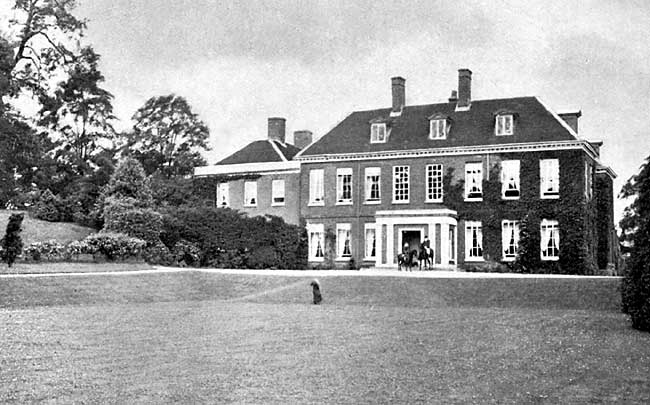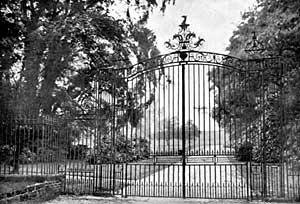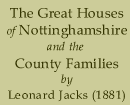< Wallingwells | Contents | Welbeck >
Watnall

Watnall Hall in 1910. The house dated from about 1690 and was demolished in 1962.
WATNALL Hall is interesting for a variety of reasons. It is an old building, situated in the corner of a county, pleasant parts of which are chosen for modern houses of more or less pretention, and which often rather spoil the landscape than add to its beauty ; it can lay claim to associations, that are to some extent mixed up with the history of the county, and it has since the early part of the seventeenth century been the seat of a family, of both antiquity and distinction—the Rollestons. These were formerly of Rolleston, in Staffordshire, from which place they took, or gave, their name. The Rollestons, of Rolleston, they were, before they disposed of their estate to the Mosleys (who have been settled there since), and came to live in this part of the country on property which they acquired by marriage a long while ago. They derived their descent through a younger son of Ralph Rolleston, who settled at Lea, in Derbyshire, about the time of Edward the Third. Some time during the reign of the good Queen Bess, Ralph Rolleston married the co-heiress of Sir Richard Bingham, the then head of a family of some consequence in the county, who lived at, and owned, Watnall Chaworth, and by this alliance the Rollestons became possessed of the house, which their descendants have occupied for generations. A considerable estate in Lincolnshire was brought into the family, somewhere about 1680, and they have held lands in these two counties ever since. The house at Watnall is unmistakably old. The beautiful iron gates—some of the best work of that famous ironworker Shaw—which serve to make fast the entrance to the shady drive leading to the higher ground, upon which the building is situated, bears traces of antiquity. In some places the metal is worn thin, and has slowly succumbed to climatic influences. The gilded eagle’s head—the crest of the Rollestons—which looks defiance on the very summit of these tall gates, has lost its lustre ; the lower work is tarnished with age. Formerly these same gates occupied a different position. They served to guard a flight of ancient and worn stone steps, almost immediately in front of the house. The steps are there still, though they are not used. Lichens have eaten into them; moneywort and other parasitic plants grow profusely from their crevices. These steps have never been moved, and I should think they never will be whilst a Rolleston owns Watnall. Mary Chaworth probably tripped light-footed down that picturesque flight after dancing at the balls with the young gallants of the county. You can see the hills of Annesley from the terrace, and it is said that Byron’s Mary sometimes escaped the vigilance of her guardians, and left her home, surreptitiously to dance at the balls, for which Watnall was famous. The house is as old as the steps. Portions of it were built in the reigns of three English monarchs— Henry the Eighth, Elizabeth, and Anne—and it is easy to see that at certain periods it has been found necessary to make alterations, with the view of remedying symptoms of decay. But these have been made with care and judgment, and the building has not suffered in consequence. It is a brick house of delightful colour, which time has laid on in the course of centuries. For a house was there as far back as 1620, when the Rollestons migrated from Staffordshire, and it is fair to suppose that a good deal of the present building was in existence then. The architecture is somewhat quaint ; from one aspect the building looks like a solid and somewhat conventional block, from another, and this, the principal one, it is agreeably broken, and almost divided into wings. Further investigation shows that it is built upon three sides of a quadrangle, and the quadrangle, and the design has been, in a measure, disturbed by the addition of a straight piece of brickwork, which enclosed several rooms.

The 17th century gates to Watnall Hall photographed in 1910.
The interior is large and roomy, and when it is stated that Mr. Lancelot Rolleston, who now owns the estate, and lives at Watnall Hall, is unmarried, it may readily be imagined that certain of the apartments are not regularly used. Under the present regime, the library and the dining room may be described as the principal room, though these are not the only apartments in the house to which interest attaches, or which call for notice in an article of this kind. The library is panelled and quiet ; supplied with a collection of books, which, from the nature of the bindings appear to have been got together at no very recent date, and with a few pictures, chief amongst which is a fine drawing of a Rolleston, surnamed Lancelot, who, in his time, was High Sheriff of the county, and who, during his ownership made some additions to the hall. There is a monument in Watnall Church to the memory of this gentleman, who was respected in the county, and esteemed by those with whom he had anything to do. On a small table, embedded in velvet, there is the hunting horn, which was presented to Mr. Rolleston, a year or two ago, as master of the South Nottinghamshire hounds, by the followers of the hunt—a token, no less of their admiration of the master’s conduct in the field, than of their appreciation of his geniality and uniform courtesy. This responsible and trying post— for even fox-hunting has its trials and responsibilities, Mr. Lancelot Rolleston accepted, on the resignation of Mr. Chaworth Musters, a few years ago, and hunting men say that the country has never furnished better sport under any previous master.
In the dining room, hanging over the mantelpiece, is a portrait of the late Colonel Rolleston (Sherwood Foresters), who, from 1837 to 1849, was one of the representatives of the southern division of the county in the House of Commons, and for some years chairman of the Nottinghamshire Quarter Sessions. This portrait was presented to Mr. Rolleston by a constituency, which was attached to him by ties, other than those represented by Parliamentary duties and electoral requirements, and it is said to be a true and faithful likeness. There are in the same room some other family portraits, which, perhaps, only have an interest for those to whom they belong, and in other parts there is a further collection of ancestors, amongst whom possibly—for their identity cannot be clearly established—is that member of the family, who, in a work little read now-a-days, is mentioned as one of the intended deliverers of an imprisoned Queen. He is there described as "a squire of good worth in the country, and a devoted Catholic man." One of those who had joined the delivering league turning traitor; the whole matter, so says the historian, was betrayed, the authors of the plot were placed in durance vile, and Mr. Rolleston, spelled in the narrative Rowlaton, was condemned to die.
On the mantelpiece in the dining room there is a small likeness of the late Canon Kingsley—whom it was Mr. Rolleston’s privilege to know intimately. One is impressed with the quaintness of some of the upper rooms at Watnall.
There are a number of bed rooms in the older part of the house, the formation of which is both peculiar and picturesque. The windows are small, and set in deep recesses. The plaster ceiling, of a pinkish colour and sloping at the sides, is extremely curious and old-fashioned. There are numbers of these rooms upstairs, and there is also a curious panelled apartment of Elizabethan date. Here there are one or two hunting pictures, to which some special family interest attaches, for Mr. Rolleston inherited his love of the chase from his ancestors. Here, too, are some heraldic devices, in stained glass, which has never been disturbed, and which has let into that old room a coloured filtration of light, for no one knows how long. All these are family shields, and the bearings are distinctly traceable and authentic. Higher up in the house there is what Mr. Rolleston calls, a lumber room, but what might fitly be described as a disused armoury. It is a grim-looking apartment. Reared up in one of the corners is a rusty collection of musketry, —a pile of ancient flint locks which were originally procured for the defence of the house when the neighbourhood was disturbed by the Luddite riots. Scattered about, are the ammunition cases, also much the worse for age, but still preserved to give an idea how warm was the reception that awaited any invasion of the Watnall domain.
From the leads of Watnall you can get glimpses of five counties, and a view of garden and field, woodland and distant hill, which it would be difficult to match in this part of the country. Beneath is the old-fashioned garden, with its gigantic laurel bushes—that in front of those old steps, like a huge wigwam made of foliage ; its curious yew hedge, which encloses the arena wherein cock-fighting formerly took place ; its old bowling green, which is now occasionally used for that game of bowls, which is threatened with extinction in these days of dangerous pastimes with its small conservatory, bright with geraniums, and calceolarias, and with its thatched bee-house, full of murmurous sound. Of that bee-house I made a closer inspection. It was designed by Mr. Rolleston, who takes considerable interest in bee culture, and is large enough inside for a study. As a matter of fact, Mr. Rolleston occasionally shares this house with the bees. The boxes in which the insects deposit their honey are so arranged that they cannot fly about in the interior of the apartment, whilst their operations can be watched and studied through glass. So the bee-house serves a double purpose, besides being an ornament to the garden. Whilst the bees are making their honey, and arranging their domestic matters in the glass cases, Mr. Rolleston is writing his letters at a table, and the apartment is filled with a soothing sound.
< Wallingwells | Contents | Welbeck >
